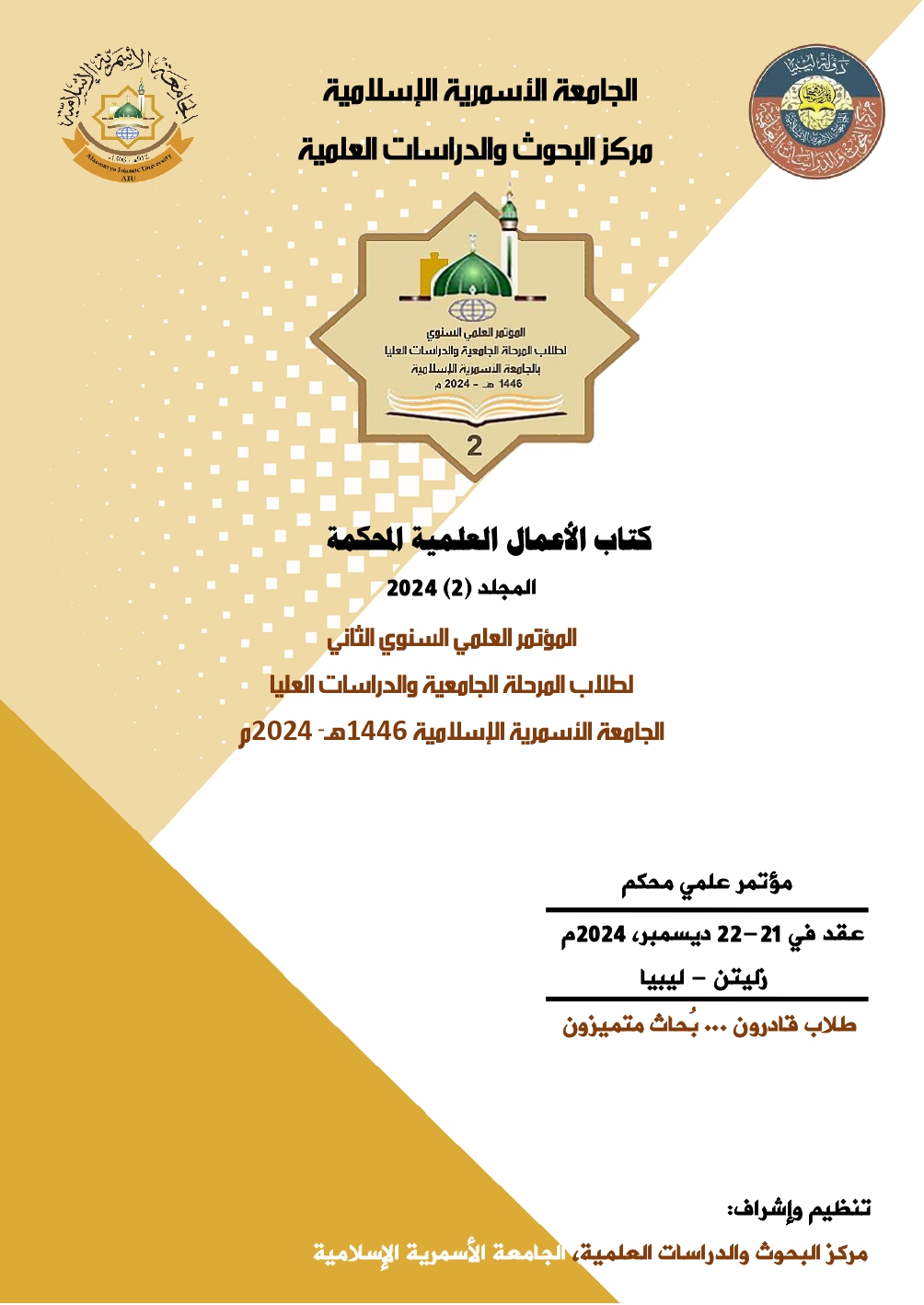Estimating the Effectiveness of Artemisia Herbalba Extract on Pathogenic Bacteria Isolated from Some patients of Zliten Medical Center
Keywords:
Artemisia, Antibacterial activity, Ethanol extract, Hexane extract, Propanol extract, Water extractAbstract
Due to the increasing rate of bacterial resistance, plants in general have become a primary source for exploring new antimicrobials. Historically and in modern healthcare, plants have served as a source of treatment for humans. One example is the Artemisia plant, which is known for its effective action against both Gram-positive and Gram-negative pathogenic bacteria. The aim of this research was to investigate the antibacterial properties of Artemisia and its potential as an alternative to certain antibiotics that have become less effective against pathogenic bacteria. Four types of pathogenic bacteria, obtained and identified from Zliten Medical Center, were used in this study. The results demonstrated that ethanol, hexane, and propanol extracts of Artemisia, at varying concentrations, along with 100% water extract, exhibited significant antibacterial effects. Among these, the propanol extract showed the highest inhibitory effect against all tested bacteria, including Staphylococcus aureus, Escherichia coli, Acinetobacter spp., and Klebsiella pneumonia. The largest inhibition zone was observed against Acinetobacter spp. using the propanol extract, followed by ethanol extract, which showed the highest inhibition against Escherichia coli. Hexane extract demonstrated inhibitory activity against Staphylococcus aureus, whereas the water extract exhibited the least effect against all tested bacterial strains. Thus, Artemisia is rich in active compounds capable of inhibiting both Gram-positive and Gram-negative bacteria, making it a strong candidate as an alternative to antibiotics.
Downloads
References
أولاً: المراجع باللغة العربية
الزربي، عبد الحميد خليفة؛ العائب، محمد الدراوي؛ عثمان، عبد الرؤوف (2018). المتاجرة بالنباتات الطبية والعطرية الطبيعية بمنطقة توكرة والمناطق المجاورة لها وأثر ذلك على النباتات المستهدفة. المؤتمر العلمي الخامس للبيئة والتنمية المستدامة بالمناطق الجافة والشبة الجافة، 25-29/7/2018 ،أجدابيا، ليبيا.
الطيف، عماد محمود؛ حمودي، منال صادق؛ محمود، عبد الرحمن رشيد؛ شاكر، منى علي (2016). دراسة المركبات الفعالة والعناصر المعدنية لمستخلصات ثمرة نبات الشيح وتأثيرها على انزيمات الكبد. مجلة كلية التربية الأساسية، 22(95)، 137-150.
فايد، خلود الهادي؛ بن علي، حسن محمد؛ غويلة، خيري الهادي، و كندي، بشرى محمد (2023). تقييم الفعالية التثبيطية لمستخلص البصل والثوم المائي ضد نمو بعض أنواع البكتيريا الممرضة. المؤتمر العلمي السنوي لطلاب المرحلة الجامعية والدراسات العليا بالجامعة، 1، 5. 13-23.
عمر، لبنى (2018). دراسة بعض الخصائص البيوكيميائية لنبات الشيح Artemisia herba albaAsso. رسالة ماجستير جامعة فرحات عباس، سطيف، الجزائر.
ثانياً: المراجع باللغة الإنجليزية
Ahameethunisa, A. R., & Hopper, W. (2010). Antibacterial activity of Artemisia nilagirica leaf extracts against clinical and phytopathogenic bacteria. BMC complementary and alternative medicine, 10, 1-6.
Ahmadizadeh, C., Monadi, A., Rezaie, A., Rad, M. G., & Jafari, B. (2018). Antibacterial activity of methanolic extract and essence of Sagebrush (Artemisia vulgaris) against pathogenic bacteria. Life Sci. J, 15(5), 69-73.
Anjali, D. B., Mohabe, S., Reddy, A. M., & Nayaka, S. (2015). Antimicrobial activities of 2-Propanol crude extract from lichen Parmotrema tinctorum (Despr. ex. Nyl.) Hale, collected from Eastern Ghats, India. Current Research in Environmental and Applied Mycology, 5(3), 160-168.
Bogdadi, H. A. A., Kokoska, L., Havlik, J., Kloucek, P., Rada, V., & Vorisek, K. (2007). In Vitro Antimicrobial Activity of Some Libyan Medicinal Plant Extracts. Pharmaceutical Biology, 45(5), 386–391.
Bordean, M. E., Ungur, R. A., Toc, D. A., Borda, I. M., Marțiș, G. S., Pop, C. R., ... & Muste, S. (2023). Antibacterial and phytochemical screening of Artemisia species. Antioxidants, 12(3), 596.
Elazzouzi, H., Khabbal, Y., Bouachrine, M., Zair, T., & Alaoui El Belghiti, M. (2018). Chemical composition and in vitro antibacterial activity of Artemisia ifranensis J. Didier essential oil Growing Wild in Middle Moroccan Atlas. Journal of EssEntial oil rEsEarch, 30(2), 142-151.
Asili, J., Emami, S. A., Eynolghozat, R., Noghab, Z. S., Bazzaz, B. S. F., & Sahebkar, A. (2015). Chemical composition and in vitro efficacy of essential oil of seven Artemisia species against ESBL producing multidrug-resistant Escherichia coli. Journal of Essential Oil Bearing Plants, 18(1), 124-145.
Mamatova, A. S., Korona-Glowniak, I., Skalicka-Woźniak, K., Józefczyk, A., Wojtanowski, K. K., Baj, T., ... & Malm, A. (2019). Phytochemical composition of wormwood (Artemisia gmelinii) extracts in respect of their antimicrobial activity. BMC Complementary and Alternative Medicine, 19, 1-8.
Yang, Y., Guo, D., Yang, S., Hu, H., Luo, X., & Wan, N. (2023). Analysis of Volatile Components and Antibacterial Activity of Silver Wormwood Essential Oils from Different Habitats by E-Nose Combined with GC-MS. Separations, 10(11), 553.
Downloads
Published
Conference Proceedings Volume
Section
License

This work is licensed under a Creative Commons Attribution-NonCommercial-NoDerivatives 4.0 International License.





